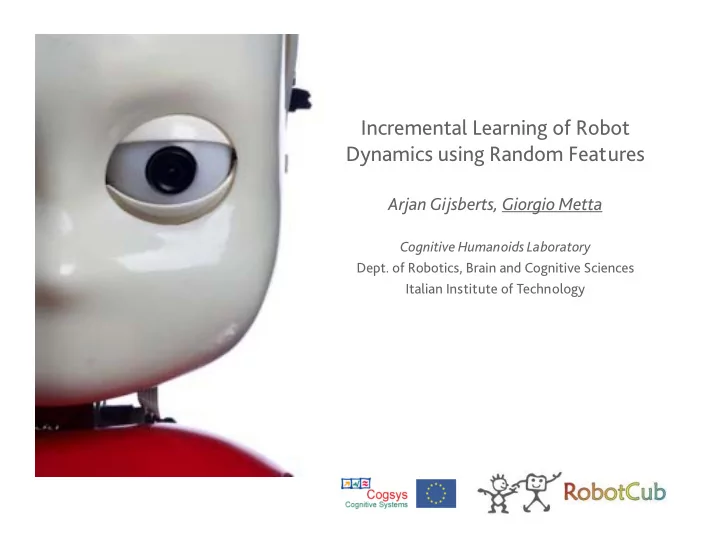

Incremental Learning of Robot Dynamics using Random Features Arjan Gijsberts, Giorgio Metta Cognitive Humanoids Laboratory Dept. of Robotics, Brain and Cognitive Sciences Italian Institute of Technology
general setting • learning incrementally – because the world is non-stationary (concept drift) • learn efficiently – real-time (hard) constraints • we’d like to learn – accurately (guarantees that learning learns) – autonomously (little prior programming)
specific setting Inertial sensor • learning body dynamics – compute external forces – implement compliant control Six axis F/T sensor • so far we did it starting from e.g. the cad models – but we’d like to avoid it
…so
some incremental learning methods • LWPR [Vijayakumar et al., 2005] • Kernel Recursive Least Squares [Engel et al., 2004] • Local Gaussian Processes [Nguyen-Tuong et al., 2009] • Sparse Online GPR [Csató and Opper, 2002] typical problems (not everywhere): • high per-sample complexity (slow learning) • increasing or unpredictable computational requirements • limited theoretical support and understanding
our method • linear ridge regression as base algorithm – efficient, elegant, effective – theoretically well-studied • possible extensions for non-linear regression and incremental updates T f x w x 1 2 2 min J w y Xw 2 2 w 1 T T w I X X X y
our method in 3 easy steps m • kernel trick f x c k x , x i i i 1 y 1 c K I • approximate kernel D 1 T k x , x E z x z x i j w i w j D d d d 1 Rahimi, A. & Recht, B. (2008) T T z x cos w x , sin w x w • make it incremental 1 T T w I y + Cholesky rank-1 update
features • O(1) update complexity w.r.t. # training samples • exact batch solution after each update • dimensionality of feature mapping trades computation for approximation accuracy • O(n²) time and space complexity per update w.r.t. dimensionality of feature mapping • easy to understand/implement (few lines of code) • not exclusively for dynamics/robotics learning!
batch experiments • 3 inverse dynamics datasets: Sarcos, Simulated Sarcos, Barrett [Nguyen-Tuong et al., 2009] • approximately 15k training and 5k test samples • comparison with LWPR, GPR, LGP, Kernel RR • RFRR with 500, 1000, 2000 random features • hyperparameter optimization by exploiting functional similarity with GPR (log marginal likelihood optimization)
batch error on 7-DOF Sarcos arm
prediction time
incremental experiments • two large scale inverse dynamics datasets from “James” and iCub humanoids (4-DOF) • realistic scenario: initial 15k training and remaining approx. 200k and 80k test samples • RFRR with 200, 500, 1000 random features • RFRR uses training samples only for hyperparameter optimization • comparison with batch Kernel RR (identical hyperparameters)
batch vs. incremental
verification (learning dynamics)
verification: time
verification: reaching x , y , z M u , v , u , v , T , V , V l l r r s g CE image fixation point to learn eye configuration
verification
affordances (learning objects)
learning object behavior
conclusions • incremental learning is advantageous when models cannot be assumed stationary • ridge regression with kernel approximation and exact update rule for efficient incremental learning • RFRR has an O(1) time and space complexity per update (suitable for hard real-time) • number of random features regulates computation vs. accuracy tradeoff
sponsors EU Commission projects: • – RobotCub, grant FP6-004370, http://www.robotcub.org – CHRIS, grant FP7-215805, http://www.chrisfp7.eu – ITALK, grant FP7-214668, http://italkproject.org – Poeticon, grant FP7-215843 http://www.poeticon.eu – Robotdoc, grant FP7-ITN-235065 http://www.robotdoc.org – Roboskin, grant FP7-231500 http://www.roboskin.eu – Xperience, grant FP7-270273 http://www.xperience.org – EFAA, grant FP7-270490 http://notthereyet.eu More information: http://www.iCub.org •
Recommend
More recommend